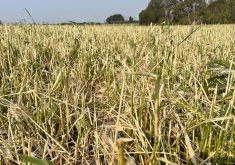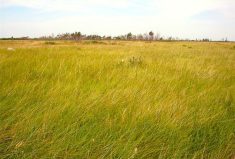Think about nitrate accumulation when salvaging cereal, oilseed, or hay crops damaged by hail, says a provincial beef and forage specialist.
“Nitrate accumulation occurs in a plant when it is injured and is not able to convert nitrate to protein efficiently after a hailstorm,” said Barry Yaremcio. “In non-legume crops, water and nutrients are pushed into the plant from the root system as quickly after the storm as was provided prior to the hail event.
“Nitrate accumulates in the top leaves and concentrations peak roughly four days after the injury. If the plants recover and new growth is observed, nitrate levels can return to normal 12 to 14 days after the injury.”
Read Also

Producers aren’t panicking over tariffs and trade threats
The influence of tariff and trade uncertainity on farm business decisions.
Nitrogen content in the soil and the stage of crop development are critical factors, he said.
“Crops such as canola and wheat have high amounts of nitrogen fertilizer applied. If the crop is thin and not overly productive, there could be significant amounts on soil nitrogen remaining in the soil into July. A crop that is thick with high yield potential would use up the available nitrogen much earlier in the growing season. With less nitrogen left in the soil, there is less available to be transported into the plant.”
Hay crops tend to have lower fertility than annual crops.
“The risk of a hay stand having high nitrate concerns is much lower,” said Yaremcio. “Alfalfa and legume crops have nodules in the root system that regulate nitrate transport into the plants. The nodules only allow as much nitrogen into the plant as is needed, therefore it is extremely rare to have nitrate accumulation in legume forages.
“There is no risk of nitrate accumulation in alfalfa or clovers.”
Other forages can be tested for nitrates.
“If the sample is taken the fourth day after the storm, the results will indicate the ‘worst-case’ situation,” said Yaremcio. “Talk to the lab and request a rush analysis, then the results could be available one to two days after the sample is received.”
Ensiling the crop will not reduce nitrate levels if the product is put up properly.
“Adequate amounts of packing, sealing with plastic as soon as possible, and allowing the silage to ferment for three to four weeks produces a stable product,” he said. “Silage that is poorly made can reduce nitrate levels, but the quality of the silage is greatly diminished.”
To get a representative sample when silage is being made, take one handful out of each load and put it into a plastic pail with a lid. At the end of the day, mix up the sample and collect a half bread bag full, squeeze out the air and freeze.
“Send the sample in for analysis on a Monday or Tuesday so it gets to the lab without being in transport over the weekend,” said Yaremcio.
Finally, talk to a feed sales rep, nutritionist, or other expert about the issue.
“Nitrate in a forage or silage can be managed so that there are no problems or difficulties encountered during the feeding program,” he said.















